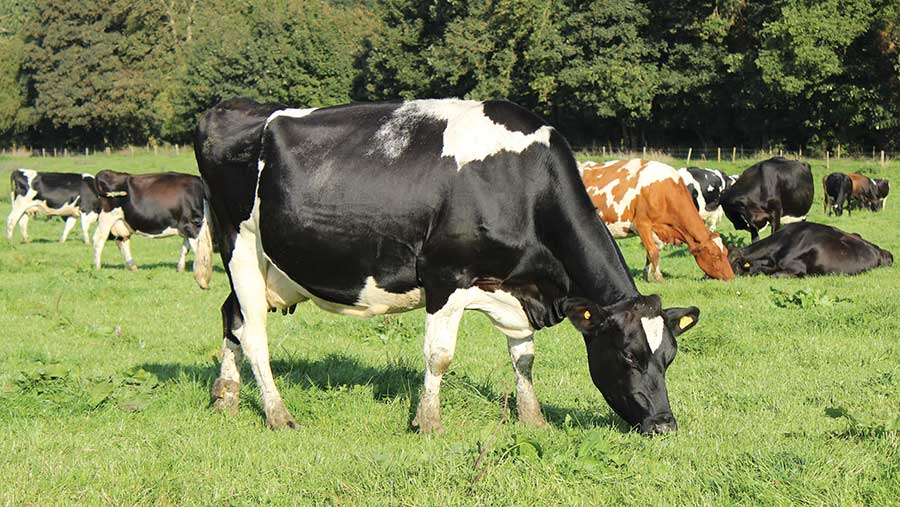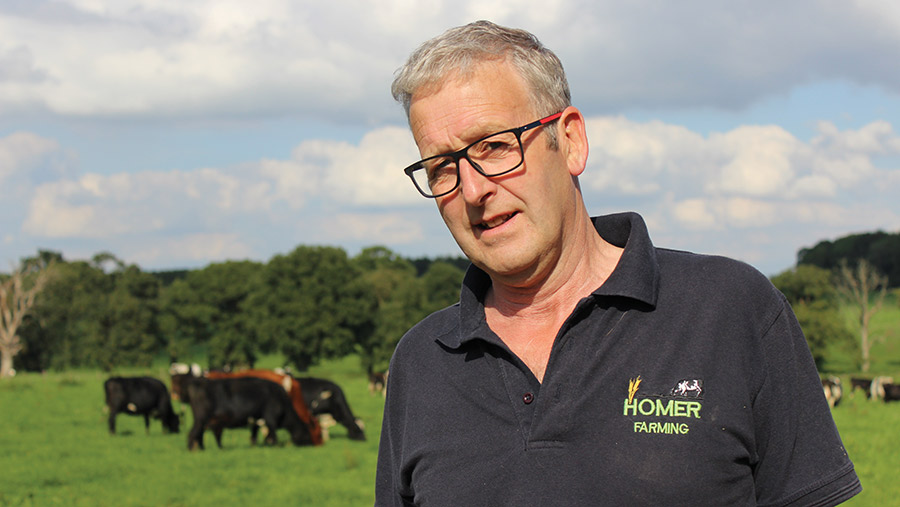How milk solids increased from fine-tuning genetic selection
 © Ann Hardy
© Ann Hardy Building up a spring-calving herd that produces a large proportion of its milk from grazed grass was a complete departure from David Homer’s previous way of breeding and farming his cows.
As a life-long tenant farmer, the drive had always been towards higher yields and increasingly Holstein bloodlines.
But when David and his two sons, Chris and Geoff, were given the opportunity of taking on an extra tenancy at Warren Farm, close to Marlborough and the Wiltshire Downs, they felt the premises were ideally suited to a grazing-based system.
See also: How a spring-calving herd started using genomics
Warren Farm Facts
- 223ha total farm area
- Grazing platform of 131ha
- 300 cows
- 12t dry matter/ha grass grown
- Housing December to February
- Calving starts second week February for 12 weeks
- Winter diet of haylage for lactation and hay for dry cows
- Sells milk to Arla
With land adjoining the Savernake Forest, the soil across the new farm’s 223ha (550 acres) was relatively poor and highly variable, ranging from some heavy clay caps, which were very water-retentive, to thin soils over a bedrock of chalk.
“We felt the soil type would lend itself to spring calving and we put in tracks and troughs and a paddock infrastructure for rotational grazing,” says David.
This meant that instead of chasing yields to match the Holstein herd at the family’s nearby Chisbury Lane Farm – where average production was 10,500 litres – the team needed a different kind of cow.

David Homer © Ann Hardy
New bloodlines
The Homers took the opportunity to acquire completely new bloodlines suited to this system, and located a batch of cows and heifers which originated at Teagasc’s Moorepark Farm in Ireland, to form the basis of the new herd.
Being part of the Irish government’s research centre meant the cattle came with a head start in terms of predicted transmitting ability (PTA).
“We brought 300 cows over from Ireland in 2013, which were mostly Friesian with an element of Jersey. We carried on breeding them to a similar type of genetics: pure Friesian and Friesian cross Jersey bulls,” says David.
“Genetic indexes have always been part of our decision making, and we were fortunate to find animals with good EBIs [economic breeding index, Ireland’s native index], which created a fantastic base from which to work.”
Now, the bloodlines are being developed using the UK’s spring calving index (SCI) which is the farm’s primary ranking tool used for shortlisting sires.
“We use SCI because the components of the index are the priority factors we look for in our cows. We choose four or five bulls a season and within that group, select each one for individual cows,” he explains.
“We don’t need heavy cows as we want to minimise soil and pasture damage, especially during the shoulders of the grazing season.
Our average cow weight is 545kg and we’d like to reduce this to 525kg for an average, mid-lactation cow, producing 525kg solids from 525kg cake.”
David is aiming to improve genetics for milk solids, as well as health, fertility and longevity.
These factors are all wrapped up in a single figure with SCI (see pie chart below), which promotes milk quality rather than volume.
This index has a strong emphasis on fertility, improves udder and leg health, and reduces maintenance costs by limiting liveweight.
Its overarching purpose is to maximise profitability for UK-based, spring block-calving, predominantly grazing herds.
Improving traits
“Once we’ve shortlisted on SCI we will drill down into components of the index, improving traits as each cow requires,” he says.
Unlike in some low-input herds, mating decisions are made on a cow-by-cow basis, which means that despite the variety of breeds, uniformity in size can still be achieved.
By carefully selecting and blending genetics, the Homers have developed a uniform herd of cattle precisely suited to their needs. “They are grazing machines,” adds David.
Today, the herd produces 5,214 litres a cow, with combined fat and protein of 419kg and 2,631 litres – just over 50% – from grazed grass (rolling 12-month average to August 2023).
David says solids yield has risen by 8% over the past decade.
Milk is sold through Arla Care, meeting the scheme’s high animal welfare, renewable energy and ecosystem requirements.
“And with high health standards and diverse swards contributing to this qualification, David is happy to acknowledge: “We have very little lameness – and we don’t really do metabolic disease.”
The only concentrates used are fed in the parlour, amounting to 0.18kg/litre, or 870kg a cow a year. This gives a cost a litre of 8.23p, which contributes to a margin over purchased feed of 35.70p/litre or over £1,700 a cow.
However, this margin is almost £200 less than the previous 12 months before milk prices dropped at the start of this year.
“We wanted to reduce costs a litre and we have done so massively, and that has definitely increased our profitability.
“However, last year the autumn calving herds had lower costs of production because they were less affected than the spring calvers by the drought.
“We would like to feed just 500kg of cake to the spring calvers, but weather and grass growing conditions don’t usually allow.
“Our main KPI for fertility is 85% in-calf in the first six weeks. That sets the pace for the whole breeding programme.”
The Holstein herd at Chisbury Lane has now been switched to autumn block-calving and the business now includes a third herd (also in Wiltshire) farmed under contract.
There is also a new herd on the Isle of Bute where Chris has taken a tenancy, while Geoff now manages Warren Farm.
David says he is completely happy with the direction of travel and the family will continue with its “cross-breeding experiment”.
“Some people enjoy squeezing as much milk as they can out of their Holsteins, but we, as a family, enjoy grazing cows. We get our kicks out of watching cows doing exactly [that],” he says.
Spring calving index (SCI)
The spring calving index (SCI) was developed by AHDB to breed more profitable cows specifically for spring block-calving herds, placing a heavy reliance on grazed grass.
Its emphasis on milk solids is balanced with high fertility, health and good functional traits in a small, efficient cow.
As an across-breed index, SCI is suitable for pure and cross-bred herds, allowing producers to compare one breed against another on the same scale.
It gives an at-a-glance figure with which to compare a New Zealand sire with a British or Irish one.
To drill down to see a particular trait, such as female fertility, it is expressed on a scale that is common to all candidate bulls.
Without this, it would be impossible to establish whether a bull from one breed was better than another for that particular trait, nor how a bull compared with one from another country.
The index has also been developed for UK-costed inputs, and its formula reflects current and projected future UK markets into which producers are selling milk.
